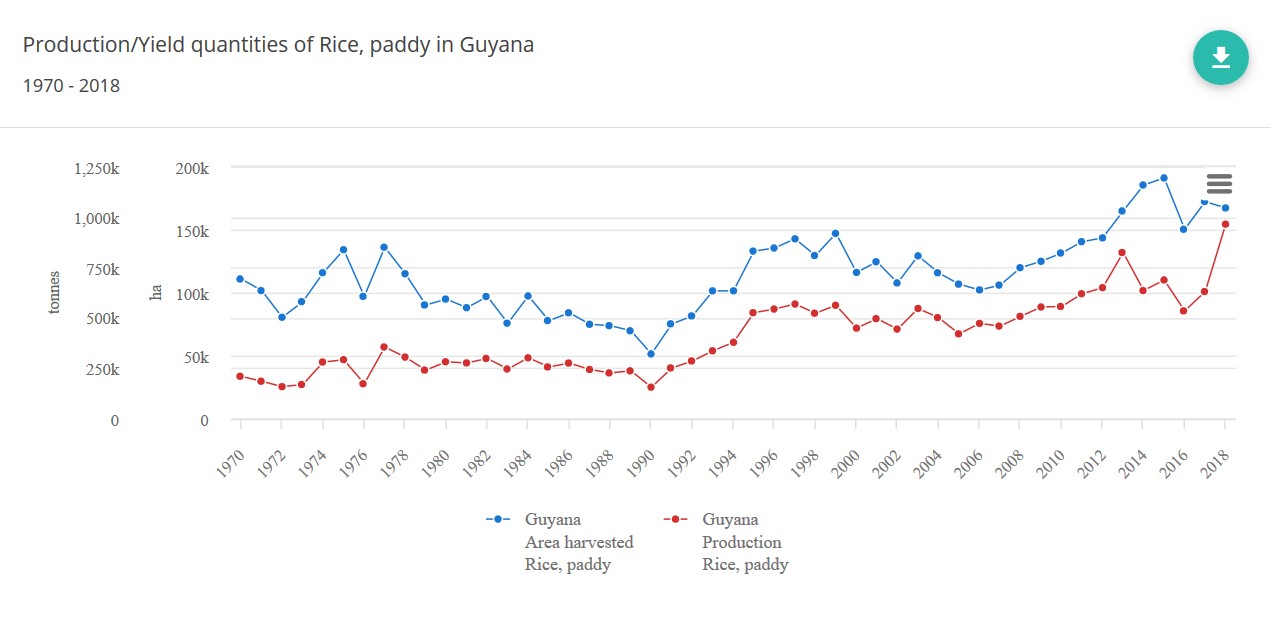Among the top Google News search results for “climate change” today, Forbes published an embarrassingly fictitious article making several false claims about climate change and rice production. The Forbes article is titled “Rice, Climate Change And A Post-COVID Opportunity For Women In Guyana.” The article is typical of establishment media articles – and particularly Forbes articles – that simply make up false climate claims out of thin air, provide no supporting data for the claims (because no supporting data exist), and then act like people who present actual scientific data and evidence are attacking science. This article is the first of three articles debunking different aspects of the multi-ridiculous Forbes article.
Forbes Senior Contributor Daphne Ewing-Chow writes that rice production volatility from COVID-19 and “climate change-fuelled [sic] droughts” can give Guyana rice farmers an opportunity to increase global market share. However, Ewing-Chow asserts “Guyana’s high vulnerability to climate change, particularly in its coastal areas … create uncertainty, instability and inefficiency in a number of areas.”
Ewing-Chow added, “A 2012 World Bank report listed flooding as the most significant risk to Guyana’s rice sector and drought as number 3. [whatever that means]. Saltwater intrusion due to rising sea level and stronger storm surges is also a major problem, which lead to a 16 per cent drop in rice production in 2016.”
Wow, that is quite a bleak assessment of climate change destroying Guyana rice production.
Fortunately for people who believe in facts and science, and unfortunately for Forbes and Ewing-Chow, the United Nations Food and Agriculture Organization (FAO) keeps meticulous records of each country’s agricultural production. So, one would expect FAO to report dramatic recent declines in Guyana rice production, given what Ewing-Chow asserts in Forbes.
Let’s take a look at the FAO data.

Wow. Guyana is enjoying a long-term increase, not decrease, in rice production. In the most recent year for which FAO reports data – 2018 – Guyana set records for highest total rice production and highest yields per acre. The eight years culminating in 2018 produced seven of the eight highest crop yields ever. Also, the Guyana Rice Department Board reports that 2019 came in as the second highest on record. Furthermore, with more than half the 2020 rice crop harvested, the Guyana Rice Department Board projects the 2020 rice crop will surpass the 2019 rice crop. So, the 10 years culminating in 2020 will have produced nine of Guyana’s 10 highest rice crops in history.
To illustrate how impressive Guyana’s recent rice production is, Guyana’s 2018 rice crop was four times larger than the 1970 crop, three times higher than the 1980 crop, six times higher than the 1990 crop, double the 2000 crop, and 70 percent higher than the 2010 crop.
That is amazing production, and an amazing trend of increasing recent crop production.
It is amusing that Ewing-Chow and Forbes highlight 2016 for its “16 per cent drop in rice production in 2016.” Now, in 2020, Ewing-Chow and Forbes certainly must be aware that the small drop in 2016 production in relation to 2015 was an aberration that lasted only one year. Ewing-Chow and Forbes must certainly also know that, more recently, 2018 produced a record Guyana rice crop and 2019 and 2020 are coming in very close to the 2018 record, as well.
The only explanation for Ewing-Chow and Forbes citing 2016 to claim climate change is harming Guyana rice production – while hiding from readers the record crop production in more recent years – is that Forbes and Ewing-Chow are dishonest shills for the fictitious climate “crisis.”
Well, whatever the motives of Ewing-Chow and Forbes, it is laughable that they claim climate change is harming rice production in Guyana. Guyana rice production continues to increase and set records, even and Forbes asserts a fictitious Guyana climate rice crisis.



















